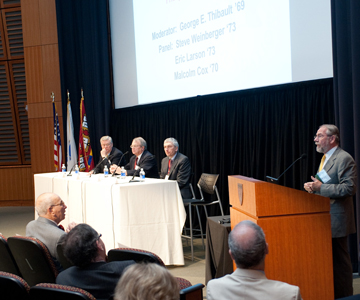
U.S. health care reform did not begin with passage of the Affordable Care Act, and it won’t be successful unless fundamental change first occurs in American medical schools.
That was the message Harvard Medical School alumni heard during an Alumni Day symposium at the Joseph B. Martin Conference Center on May 31 as a group of U.S. health care leaders discussed how the nation should proceed as it attempts to cut costs and improve health care for millions.
“This must be a time of innovation. If we expand just to do what we were doing before, then we will not be serving the public,” said symposium moderator George E. Thibault, ’69, discussing how the health care reform movement actually began a decade ago, triggered by a looming physician shortage that spurred the opening of 15 new medical schools.
Thibault, who is president of the Josiah Macy Jr. Foundation, said in recent years it has became even clearer that the status quo is unsustainable, that health care is too expensive and not available to enough people, and outcomes are far too variable. Reform, however, won’t come with passage of the ACA alone, he said.
“Without [medical] education reform, we will not have lasting and enduring health care reform,” Thibault said.
For Thibault and other members of the symposium panel, true reform can only begin in the classroom, when educational curricula become more aligned with the health needs of the public.
“We have to change the culture of the training environment,” said panelist Steve Weinberger, ’73, executive vice president and chief executive officer of the American College of Physicians.
In the past, Thibault explained, curricula were developed first, and then students were taught and assessed. Now, he suggested, curricula should be designed last, after public health needs are assessed, and they should include innovations such as interprofessional and interdisciplinary training, new models of clinical education, new content to complement the biological sciences, competency-based and individualized education tracks to speed the training process, and incorporation of new educational technologies.
“Medical education used to be about how to impart knowledge and teach how to take care of patients,” Weinberger said. “The question now is: what kind of quality of care should they deliver?”
With more than $2.7 trillion spent on health care in the U.S. in 2011, and an estimated $210 million paid for unnecessary services, such as imaging and tests, Weinberger said educators must grapple with specific training issues related to these soaring costs. These issues range from a physician’s fear that he or she might “miss something” when formulating a diagnosis, to the fact that very often care providers don’t even know what costs are associated with the tests they order for patients.
“Part of our ethical and professional responsibility is to control costs,” Weinberger said.
To that end, he said, medical school faculty must start asking appropriate questions when training students. Is a test necessary? Did a patient already have it? Was it cost effective?
“As physicians, we should be change agents,” said Eric B. Larson, ’73, vice president for research at the Group Health Research Institute. “We should be people who make things better wherever we find them.”
Successful reform will also be based upon a system of integrated care, Larson added, explaining that previous curriculum reform efforts were either science based or problem based.
Now, Larson said, education reform should follow a systems-based approach that involves destruction of professional “silos,” enabling doctors, nurses and pharmacists to all work together to deliver the best possible care. He advocated the creation of “clinical microsystems” controlled by “frontline clinicians whose primary work is patient care.”
The encouraging news, the panelists agreed, was that the time is ripe for change in the classroom.
“I’ve never seen a time more propitious for reform than today,” said Malcolm Cox, ’70, chief academic affiliations officer for the Veterans Health Administration, U.S. Department of Veterans Affairs, in Washington DC.
What will be critical to success, Cox added, is the alignment of education reform with system reforms, moving the focus from delivery of care to enhancement of well-being.
Cox said the U.S. government spent millions to create an integrated health care model within the VA system and it began, first, with redesign of primary care units. He said VA hospitals in five locations around the country created primary care “teamlets” formed around each patient, including a primary care provider, an RN case manager, a clinical associate such as an LPN, and a clerk.
So effective was the new model, Cox said, that the VA saw a 6 percent reduction in acute admissions and $596 million in total costs avoided over the first three years. Productivity also increased with the team models, he said.
Establishing and maintaining interprofessional teams was critical to the success of the effort, Cox said, but he acknowledged that it is hard to achieve. Faculty collaboration in any curriculum revision will be key to ensuring that new, interdisciplinary approaches are adopted.
“Culture matters most of all,” Cox said, when it comes to shifting medicine from patient-centered care to patient-driven care.


